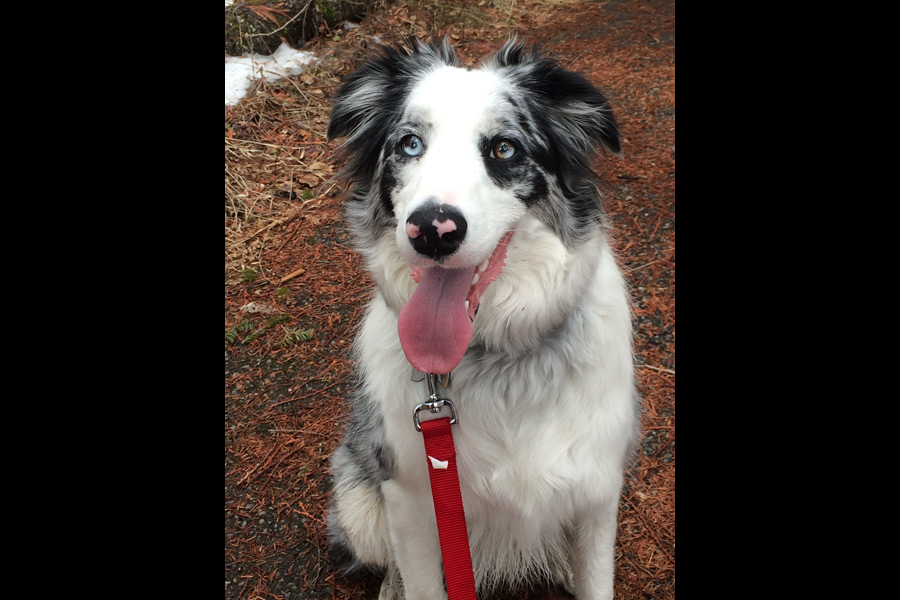‘Bark Ranger’ to Protect Glacier Park Wildlife
Gracie is a 2-year-old female border collie who will work to deter wildlife
By Beacon Staff
Meet Gracie, Glacier National Park’s new “bark ranger.”
With the help of the Glacier National Park Conservancy, Glacier Park is implementing a Bark Ranger pilot project to determine if a trained herding dog could help reduce human-wildlife interactions at Logan Pass this summer.
Gracie is a 2-year-old female border collie who will work to deter wildlife from approaching visitors. She is currently being trained by the staff at the Wind River Bear Institute in Florence.
Mark Biel, the dog’s owner and Glacier National Park’s natural resources program manager, is being trained as her handler. He plans to conduct wildlife shepherding activities with Gracie at the Logan Pass parking lot and visitor center. She is expected to be on duty by mid-July.
The shepherding will only occur if the wildlife shows no signs of stress from interaction with humans and vehicles. Shepherding will not occur if it is too hot, if there are other wildlife in the area, or if there is too much traffic and crowding in the parking lot, according to the National Park Service.
“This program represents a proactive method of wildlife management. The park is trying to provide for safe wildlife viewing by moving wildlife a safe distance from a known area of high visitor use,” said Biel. “Through the use of a wildlife shepherding dog and educational visitor contacts, we hope to prevent adverse human–wildlife interactions.”
Biel describes Gracie as a “medium energy dog that loves to have a job to do.”
Biel and Gracie will also act as wildlife ambassadors, reminding people about staying a safe distance from wildlife as well as explaining the dangers to both people and wildlife, of approaching, touching, and feeding habituated wildlife. The Bark Ranger team will also be available to talk to schools and other groups about wildlife management and concerns about habituated wildlife.
Gracie will be trained not to make physical contact with wildlife. She will wear an orange vest or harness indicating that she is a wildlife service animal and will only be off-leash during the shepherding activity. Once wildlife have been moved a safe distance away from the designated area, the shepherding will stop and she will be leashed.
An increase in park visitation has led to an increase in human–wildlife interactions at Logan Pass in recent years. Visitor interactions with mountain goats and bighorn sheep can be dangerous for both people and wildlife, park officials say. While no serious injuries have been reported at Logan Pass, habituated wildlife have caused serious injury and even death to visitors in other national parks and wild areas. Wildlife habituation can also lead to the death of the animal.
To date, park employees have used conventional hazing methods, such as arm-waving, shouting, use of sirens, shaking cans of rocks, and moving vehicles, to move goats and sheep out of the parking lot. But the animals tend to return within a short period of time, according to park officials. Because mountain goats and bighorn sheep have an innate fear of predators, however, it is expected that the adverse conditioning activities will encourage the wildlife to stay away for longer periods.
“This program represents a proactive method of wildlife management in which the park is trying to allow for safe wildlife viewing by moving wildlife a safe distance from a known area of high visitor use,” said Biel. “Through the use of a wildlife shepherding dog and visitor contacts, it is hoped that situations which could lead to adverse human–wildlife interactions will be mitigated before they can occur.”
In the 1990s, Glacier National Park contracted with the Wind River Bear Institute to have trainers and their Karelian bear dogs help manage habituated roadside bears. The project was successful in keeping bears away from the road for the remainder of the visitor season. Waterton Lakes National Park, in Canada, contracts with a business that uses border collies to move habituated deer out of the Waterton townsite before the deer give birth. This has greatly reduced the number of dangerous deer–human encounters. Airports across the country use trained herding dogs to prevent wildlife–aircraft collisions by keeping birds and deer away from runways.